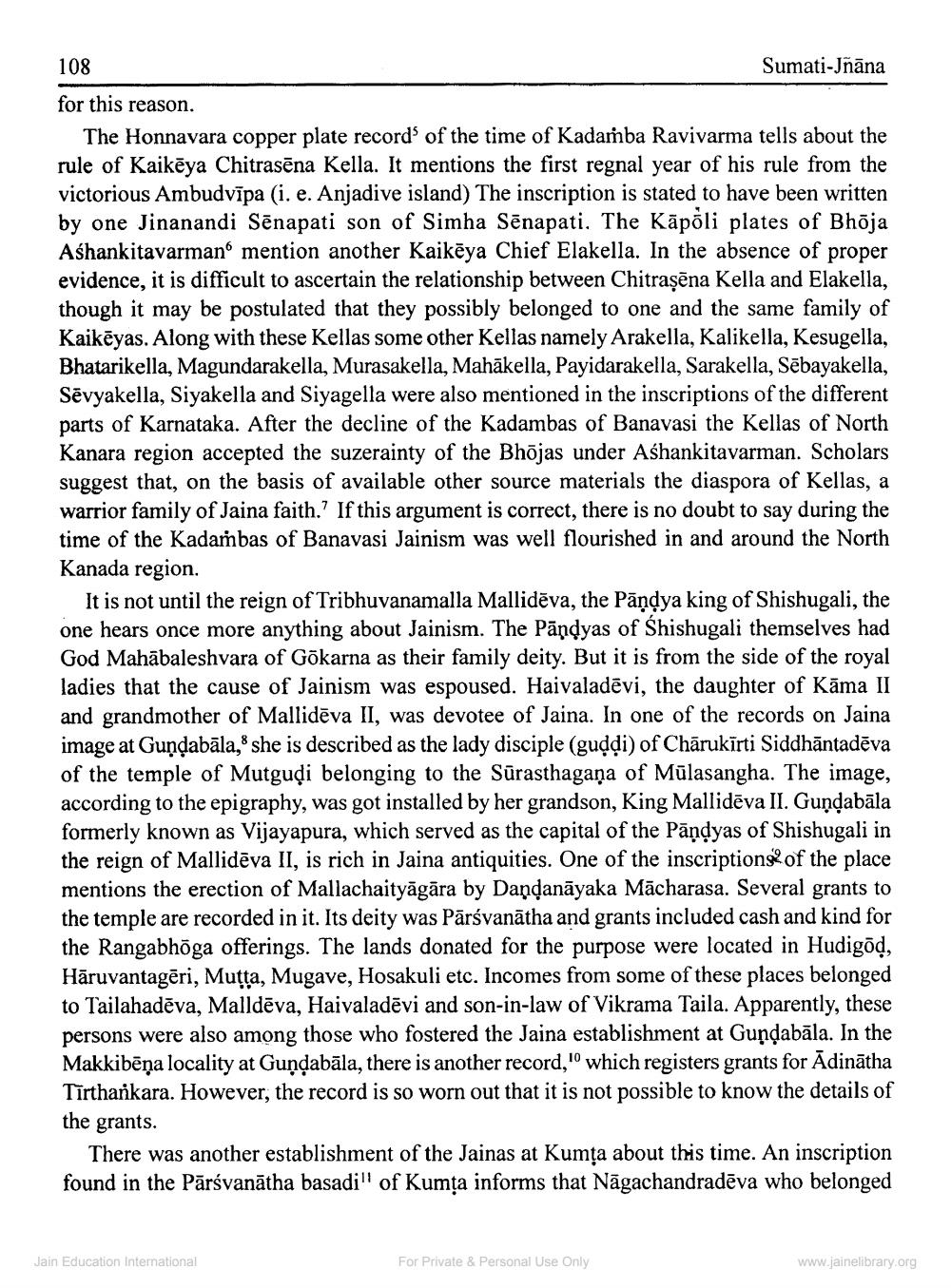________________
108
Sumati-Jnāna for this reason.
The Honnavara copper plate records of the time of Kadamba Ravivarma tells about the rule of Kaikēya Chitrasēna Kella. It mentions the first regnal year of his rule from the victorious Ambudvīpa (i. e. Anjadive island) The inscription is stated to have been written by one Jinanandi Sēnapati son of Simha Sēnapati. The Kāpõli plates of Bhõja Ashankitavarmano mention another Kaikeya Chief Elakella. In the absence of proper evidence, it is difficult to ascertain the relationship between Chitrașēna Kella and Elakella, though it may be postulated that they possibly belonged to one and the same family of Kaikēgas. Along with these Kellas some other Kellas namely Arakella, Kalikella, Kesugella, Bhatarikella, Magundarakella, Murasakella, Mahākella, Payidarakella, Sarakella, Sēbayakella, Sēvyakella, Siyakella and Siyagella were also mentioned in the inscriptions of the different parts of Karnataka. After the decline of the Kadambas of Banavasi the Kellas of North Kanara region accepted the suzerainty of the Bhājas under Ashankitavarn suggest that, on the basis of available other source materials the diaspora of Kellas, a warrior family of Jaina faith.? If this argument is correct, there is no doubt to say during the time of the Kadambas of Banavasi Jainism was well flourished in and around the North Kanada region.
It is not until the reign of Tribhuvanamalla Mallidēva, the Pāņdya king of Shishugali, the one hears once more anything about Jainism. The Pāndyas of Shishugali themselves had God Mahābaleshvara of Gokarna as their family deity. But it is from the side of the royal ladies that the cause of Jainism was espoused. Haivaladēvi, the daughter of Kāma II and grandmother of Mallidēva II, was devotee of Jaina. In one of the records on Jaina image at Gundabāla, she is described as the lady disciple (guddi) of Chārukīrti Siddhāntadēva of the temple of Mutgudi belonging to the Sūrasthagana of Mūlasangha. The image, according to the epigraphy, was got installed by her grandson, King Mallidēva II. Gundabāla formerly known as Vijayapura, which served as the capital of the Pāņdyas of Shishugali in the reign of Mallidēva II, is rich in Jaina antiquities. One of the inscriptions of the place mentions the erection of Mallachaityāgāra by Dandanāyaka Mācharasa. Several grants to the temple are recorded in it. Its deity was Pārsvanātha and grants included cash and kind for the Rangabhöga offerings. The lands donated for the purpose were located in Hudigod, Hāruvantagēri, Mutta, Mugave, Hosakuli etc. Incomes from some of these places belonged to Tailahadēva, Malldēva, Haivaladēvi and son-in-law of Vikrama Taila. Apparently, these persons were also among those who fostered the Jaina establishment at Gundabāla. In the Makkibēņa locality at Gundabāla, there is another record,'' which registers grants for Ādinātha Tīrthankara. However, the record is so worn out that it is not possible to know the details of the grants.
There was another establishment of the Jainas at Kumta about this time. An inscription found in the Pārsvanātha basadi" of Kumta informs that Nāgachandradēva who belonged
Jain Education International
For Private & Personal Use Only
www.jainelibrary.org




